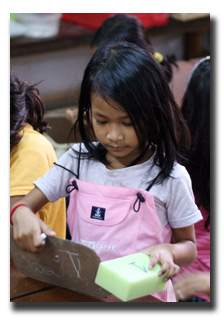|
|

The situation in Cambodia Cambodia has a young demographic structure with 44.3% of the population under 18 years of age. A combination of severe decimation of the population during nearly three decades of war and civil conflict, a post-war boom and the low average life expectancy of 57 years, are reasons behind the unbalanced population demography. According to official statistics, 35% of the population in Cambodia lives below the poverty line (1800 Riel / USD 0.45 per person, per day). Approximately 80% of the population lives in rural areas4 where the highest poverty and the lowest school attendance is found5. Crop failures, weather conditions, environmental degradation, health problems, landlessness and lack of access to land make families very vulnerable. Lack of opportunities such as poor access to assets, education and skills training, lack of infrastructure and inadequate farming technology are among the reasons behind poverty. Though it is also widespread in high social classes, increased violence against women, rape, domestic violence and trafficking of women and children might be symptomatic of poverty. It may also be symptoms of a post-war stress reaction and for many the only solution to handle their stressful life. Street Children in Cambodia In Phnom Penh there are, on a daily basis, 1,000-1,500 street children who have completely cut ties with their families and have made the streets their home. According to the figures accepted by UNICEF, there are between 10,000-20,000 street children working on the streets, who have kept ties with their families and return home either regularly or irregularly. Mith Samlanh estimates that there are between 500 and 1,500 children belonging to street living families. This figure fluctuates, depending on the situation in the provinces. There are many reasons that children end up on the streets: Poverty HIV/AIDS Drugs Migration For more detailed information about street children in Cambodia, download a copy of the Street Children Profile. The children at Mith Samlanh Students at Mith Samlanh range in ages from babies up to 24. Mith Samlanh is one of the few organisations that provides support to the 18 to 24 year age group. These children and youth come to Mith Samlanh for a variety of reasons, and Mith Samlanh does everything to try to reintegrate these young people back into society, into school, employment or back into their families. For many young children, regaining their self esteem is a vital step in moving away from life on the streets. While at Mith Samlanh, they are encouraged to learn how to express themselves through art, sport and culture and interacting with other children. Mith Samlanh outreach staff work on the streets to identify children and youth who could benefit from the services provided, but children are never forced to come to the center, or to stay there. It is entirely the decision of the children and young people to participate in activites, go to school or learn a trade at our center. It is this open door policy that is one of the reasons Mith Samlanh has a high success rate, of graduating students, children returning to families or coming clean from drugs. |

|
|
|
|
| Copyright © 2013 Mith Samlanh. All rights reserved. | Home - FAQs - Site Map - Feedback - Staff Login |







